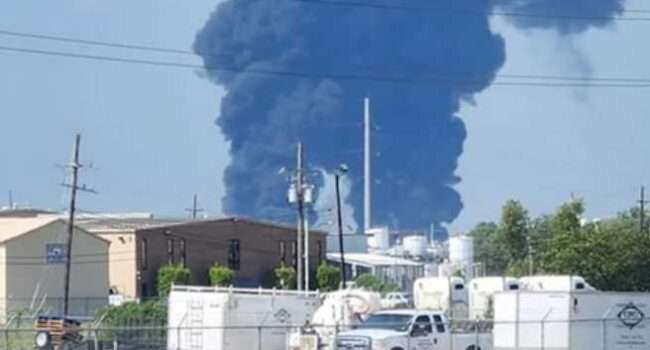“Such events are an all-too-common and exceptionally dangerous reality for those living within fossil fuel and petrochemical ‘sacrifice zones,'” observed one researcher.

A mandatory evacuation was ordered for thousands of people living within a two-mile radius of a Marathon Petroleum refinery in Louisiana’s so-called “Cancer Alley” after a chemical leak and massive fire broke out at a storage tank there on Friday.
The temporary evacuation order, which Marathon Petroleum called “precautionary,” followed a leak of naphtha—a hazardous and highly flammable liquid hydrocarbon mixture—and blaze at the refinery in Garyville in St. John the Baptist Parish, located about 45 miles upriver from New Orleans.
About 8,660 people live within two miles of the refinery, according toNola.com. One of them, 42-year-old Lashonda Melancon, said she was trying to figure out where to go with her 14-year-old daughter.
“I’ve got asthma bad and this is not good for me,” she said.
People living near the refinery said flames could be seen dozens of feet in the air. The smoke plume from the disaster was visible from outer space.
Marathon Petroleum said in a statement: “The release and fire are contained within the refinery’s property and there have been no injuries. As a precaution, air monitoring has been deployed in the community. No off-site impacts have been detected. All regulatory notifications have been made.”
However, contained does not mean controlled—the latter means extinguished—and Marathon Petroleum spokesperson Justin Lawrence said the company did not know when the blaze would be put out.
Operational since 1977, the 200,000-barrel-per-day facility is the newest oil refinery in the United States. Marathon Petroleum’s three biggest shareholders are the Vanguard Group, SSgA Funds Management, and Blackrock, private equity firms that have come under fire for financing fossil fuel expansion during a worsening climate emergency.
In May, Reutersreported there had been 13 U.S. refinery fires in 2023, the majority of them along the Gulf Coast.
St. John the Baptist Parish is located in what’s known as Cancer Alley or Death Alley, a swath of predominantly Black parishes—the Louisiana equivalent of counties—between New Orleans and Baton Rouge containing nearly 150 oil refineries and plastics and chemical plants, many of them located along or near the Mississippi River.
In neighboring St. James Parish, the U.S. Environmental Protection Agency has reported an 800% cancer hazard increase due to petrochemical facilities in the parish between 2007 and 2018.
The area is also known as a “sacrifice zone,” or place where polluting industrial facilities are built in close proximity to residents—usually people of color or those with low income.
Responding to the disaster, Antonia Juhasz, senior fossil fuel researcher at Human Rights Watch, wrote on the social platform formerly known as Twitter that “such events are an all-too-common and exceptionally dangerous reality for those living within fossil fuel and petrochemical ‘sacrifice zones.'”
